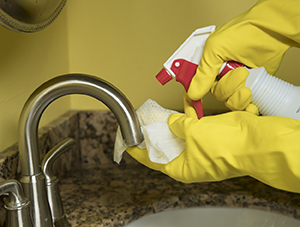Controlling Allergens: Mold
If you have a mold allergy, your immune system overreacts when you breathe in mold spores. A mold allergy can cause coughing, itchy eyes, and other symptoms that make you miserable. In some people, a mold allergy is linked to asthma and exposure causes restricted breathing and other airway symptoms. Constant exposure to allergens means constant allergy symptoms. That's why controlling or staying away from the allergens that cause your symptoms is an important part of your treatment. If you are allergic to mold, the tips below may help reduce your exposure.
Not all molds cause allergy symptoms. Some of the most common molds that cause allergy symptoms are:
-
Alternaria
-
Aspergillus
-
Cladosporium
-
Penicillium
Mold allergy
Molds are tiny fungi whose spores float through the air. They like damp environments and need 4 things to grow: food, air, appropriate temperature, and water. Molds can be found outdoors, in homes, and in other buildings. . Spores are microscopic seed particles that travel through the air. Molds grow best in dark, damp places. Outside, mold grows on rotting logs, wet leaves, certain grasses, and weeds. In the home, mold often grows in or on the following:
-
Damp basements and closets
-
Bathrooms (especially shower stalls)
-
Places where fresh food is stored
-
Refrigerator drip trays
-
House plants
-
Air conditioners
-
Humidifiers
-
Garbage cans or waste baskets
-
Mattresses
-
Upholstered furniture
-
Old foam rubber pillows
-
Walls or other home structures if there has been water damage from a flood or leak. You may not be able to see mold in walls.
Controlling mold
 |
| Keep damp areas clean to help prevent mold from growing. |
Try the following:
-
Check your local news for outdoor mold spore counts. When they are high, stay inside as much as possible.
-
Drain wet areas of your yard, and clean up leaves and weeds before they begin to rot. If you compost, keep compost piles away from the house. Ask someone else to do these things for you or wear an N95 mask, a hat, and sunglasses if you must do it yourself.
-
If you are outside when mold counts are high, bathe, wash your hair, and change your clothes afterward.
-
Use products with bleach to clean the shower or tub. Also, clean the shower curtain.
-
Fix leaky faucets or leaks in the roof right away.
-
While bathing or showering, leave a window open or use a fan. Leave the shower stall and bathroom door open after bathing to help it air out.
-
If your house or basement is damp, use a dehumidifier. Empty once a day and make sure to clean it at least twice a week to prevent mold. .
-
If you have water damage in your house, have a professional clean up the damp areas and fix the leaks as soon as possible. Painting over a water damaged area may conceal the mold. But it won't get rid of it.